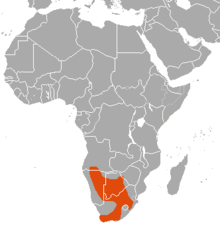| Red hartebeest | |
|---|---|

| |
| At Etosha National Park, Namibia | |
| Scientific classification | |
| Domain: | Eukaryota |
| Kingdom: | Animalia |
| Phylum: | Chordata |
| Class: | Mammalia |
| Order: | Artiodactyla |
| Family: | Bovidae |
| Subfamily: | Alcelaphinae |
| Genus: | Alcelaphus |
| Species: | |
| Subspecies: | A. b. caama
|
| Trinomial name | |
| Alcelaphus buselaphus caama | |

| |
| Distribution of red hartebeest (in orange) | |
| Synonyms | |
|
Alcelaphus buselaphus caama G. Cuvier, 1804 | |
The red hartebeest (Alcelaphus buselaphus caama), also called the Cape hartebeest or Caama, is a subspecies of the hartebeest found in Southern Africa. More than 130,000 individuals live in the wild. The red hartebeest is closely related to the tsessebe and the topi.
Alcelaphus buselaphus caama is a large African antelope of the family Bovidae, one of ten subspecies; it is sometimes treated as a separate species, A. caama. Commonly known as the red hartebeest, it is the most colorful hartebeest, with black markings contrasting against its white abdomen and behind. It has a longer face that other subspecies, with complex curving horns joined at the base.[4] The average weight of a male is about 150 kg, and female is 120 kg. Their average shoulder height is 135 cm, and horns are 60 cm long. The life expectancy of a red hartebeest is around 19 years.[5] Little sexual dimorphism is noted between males and females, showing no distinct identifiable physical features, but body size is slightly affected. Horn size, however, expresses more dimorphism between males and females, as males fight and defend themselves for sexual selection. Thus, male skull weight and circumference is slightly greater than that of the female.[6] Hartebeests have an excellent sense of hearing and smell, although their sense of sight is poor. When alarmed, hartebeests flee, reaching a maximum speed of 55 km/h. Their evasion tactic is to induce confusion by running in a zigzag pattern, making it difficult for predators to catch them.[7]
- ^ IUCN SSC Antelope Specialist Group (2017). "Alcelaphus buselaphus ssp. caama". IUCN Red List of Threatened Species. 2017: e.T814A50181496. doi:10.2305/IUCN.UK.2017-2.RLTS.T814A50181496.en. Retrieved 12 November 2021. Database entry includes a brief justification of why this species is of least concern
- ^ Geoffroy Saint-Hilaire, É. (1803) Catalogue des mammifères du Muséum National d'Histoire Naturelle. Muséum National d'Histoire Naturelle, Paris.
- ^ Wilson, Don E. & Reeder, DeeAnn M. (eds.) (2005). Mammal Species of the World. A Taxonomic and Geographic Reference (3rd ed), Johns Hopkins University Press, 2.
- ^ hartebeest. Encyclopædia Britannica Online.
- ^ Red Hartebeest Archived 28 May 2013 at the Wayback Machine. SMJ Safaris. 2012.
- ^ Capellini, I. (2007). "Dimorphism in the hartebeest. Sex, size and gender roles: evolutionary studies of sexual size dimorphism", pp. 124–132, DJ Fairbairn, WU Blanckenhorn & T. Szekely (Eds).
- ^ A Guide to the: Red Hartebeest – Alcelaphus buselaphus Archived 21 May 2013 at the Wayback Machine. EcoTravel.co.za 2012.
